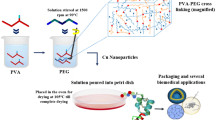Abstract
Isotactic polypropylene (PP) composite films were developed, with incorporation of CaCO3 particles as active filler. Stearic acid was used for the surface treatment of CaCO3 to provide composite films having improved mechanical, thermal and barrier properties against oxygen as well as water vapor, in comparison to neat PP films. The filler was melt mixed with PP in a twin-screw extruder, and the films produced through melt blowing. A slight reduction in T g values of the filled PP films was observed, along with an increase in the overall crystallization extent relative to neat PP films. X-ray diffraction data confirmed that the CaCO3 particles served as a β-nucleating agent capable of promoting the formation of the β-crystalline phase of PP and reducing the spherulite size, with stearic acid-coated CaCO3 being most effective in promoting these features. Exposing the films to microwave radiation altered their properties; at low irradiation power, the T g values and the degree of β-crystallization were enhanced, and barrier properties against oxygen and water vapor showed improvements. In contrast, no significant changes in the appearance of the film surface were evident highlighting the potential of these PP-based composite films in microwave packaging applications.






Similar content being viewed by others
References
Metın D et al (2004) The effect of interfacial interactions on the mechanical properties of polypropylene/natural zeolite composites. Compos Part A Appl Sci Manuf 35(1):23–32
Yang K et al (2006) Morphology and mechanical properties of polypropylene/calcium carbonate nanocomposites. Mater Lett 60(6):805–809
Vladimirov V et al (2006) Dynamic mechanical and morphological studies of isotactic polypropylene/fumed silica nanocomposites with enhanced gas barrier properties. Compos Sci Technol 66(15):2935–2944
Villaluenga J et al (2007) Gas transport properties of polypropylene/clay composite membranes. Eur Polymer J 43(4):1132–1143
Supaphol P, Harnsiri W, Junkasem J (2004) Effects of calcium carbonate and its purity on crystallization and melting behavior, mechanical properties, and processability of syndiotactic polypropylene. J Appl Polym Sci 92(1):201–212
Dai Lam T et al (2009) Effect of nanosized and surface-modified precipitated calcium carbonate on properties of CaCO 3/polypropylene nanocomposites. Mater Sci Eng A 501(1):87–93
Mihajlović S et al (2009) Influence of the modification method on the surface adsorption of stearic acid by natural calcite. J Serb Chem Soc 67:1–19
Shentu B, Jipeng L, Zhixue W (2006) Effect of oleic acid-modified nano-CaCO3 on the crystallization behavior and mechanical properties of polypropylene. Chin J Chem Eng 14(6):814–818
Lin Y et al (2010) The toughening mechanism of polypropylene/calcium carbonate nanocomposites. Polymer 51(14):3277–3284
Osman MA, Atallah A, Suter UW (2004) Influence of excessive filler coating on the tensile properties of LDPE–calcium carbonate composites. Polymer 45(4):1177–1183
Mihajlović S et al (2009) Surface properties of natural calcite filler treated with stearic acid. Ceram Silik 53(4):268–275
Yoğurtcuoğlu E, Uçurum M (2011) Surface modification of calcite by wet-stirred ball milling and its properties. Powder Technol 214(1):47–53
Mann S et al (1988) Controlled crystallization of CaCO3 under stearic acid monolayers. Nature 334(6184):692–695
Agarwal V, Igasaki Y, Mitsuhashi H (1976) Evaporated films of stearic acid studied by X-ray diffraction. Thin Solid Films 33(3):L31–L35
Yang G et al (2012) Crystallization behavior of isotactic polypropylene induced by competition action of β nucleating agent and high pressure. Colloid Polym Sci 290(6):531–540
Wang C et al (2013) β-Crystallization of isotactic polypropylene in the presence of β-nucleating agent and different crystallinity poly (ethylene terephthalate). Thermochim Acta 559:17–22
Siripatrawan U, Burgess G, Harte B (2000) The effect of repeated microwave heating, fill level and temperature on the impact resistance of a polypropylene syrup bottle. Packag Technol Sci 13(5):205–210
Osorio A, dos Santos L, Bergmann C (2011) Evaluation of the mechanical properties and microstructure of hydroxyapatite reinforced with carbon nanotubes. Rev Adv Maters Sci 27:58–63
Zhang X et al (2004) Oriented structure and anisotropy properties of polymer blown films: HDPE, LLDPE, LDPE. Polymer 45(1):217–229
Móczó J, Pukánszky B (2008) Polymer micro and nanocomposites: structure, interactions, properties. J Ind Eng Chem 14(5):535–563
Tomé LC et al (2011) Preparation and evaluation of the barrier properties of cellophane membranes modified with fatty acids. Carbohydr Polym 83(2):836–842
Yang Z, Tang Y, Zhang J (2013) Surface modification of CaCO3 nanoparticles with silane coupling agent for improvement of the interfacial compatibility with styrene-butadiene rubber (SBR) latex. Chalcogenide Lett 10(4):131–141
Pradittham A et al (2014) Surface modified CaCO3 by palmitic acid as nucleating agents for polypropylene film: mechanical, thermal and physical properties. Energy Procedia 56:264–273
Acknowledgments
The authors wish to acknowledge the financial support from Thammasat University and NSTDA-University-Industry Research Collaboration (NUI-RC). Moreover, the authors would like to thank the Department of Materials and Metallurgical Engineering, Rajamangala University for supporting a twin-screw extruder.
Author information
Authors and Affiliations
Corresponding authors
Rights and permissions
About this article
Cite this article
Pechyen, C., Ummartyotin, S. Development of isotactic polypropylene and stearic acid-modified calcium carbonate composite: a promising material for microwavable packaging. Polym. Bull. 74, 431–444 (2017). https://doi.org/10.1007/s00289-016-1722-3
Received:
Revised:
Accepted:
Published:
Issue Date:
DOI: https://doi.org/10.1007/s00289-016-1722-3




